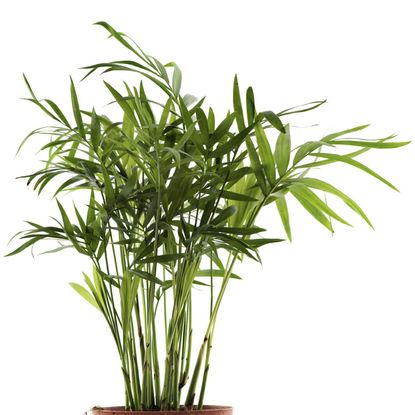Bamboo Palm: Complete Plant Care And Growing Guide
Caring for a bamboo palm indoors is about as easy as it gets and, while it resembles the larger bamboo species, it’s actually an attractive tropical houseplant.

Bamboo Palm: Ultimate Plant Care And Growing Guide
If you want to bring a bit of the tropics into your home, try growing a bamboo palm. The bamboo palm plant is named for its resemblance to bamboo but is not a member of the same genus.
Growing a bamboo palm tree is a terrific way to get the look of a palm but with a restrained size and low light requirement. While this variety of palm can be grown in USDA zones 10-11 but is more common to see a bamboo palm indoors, grown as a houseplant. Keep reading to learn how to grow and care for a bamboo palm.
Quick Facts:
Botanical name: Chamaedorea seifrizii
Height: 6.5 feet (2 m)
Spread: 3-6 feet (1-2 m)
Sun exposure: Partial shade
Soil requirements: Rich, moist, well-draining
Gardening tips, videos, info and more delivered right to your inbox!
Sign up for the Gardening Know How newsletter today and receive a free download of our most popular eBook "How to Grow Delicious Tomatoes."
Hardiness zones: USDA 10-11
When to plant: Spring
Bamboo Palm Care
Native to Mexico and Central America where it can be found growing as an understory plant, bamboo palm trees require similar conditions to thrive. That said, however, this palm is as easy-care as they come.
Light
Bamboo palm plants are fairly unfussy regarding their light. They thrive equally in low to medium light conditions. They will even tolerate bright light as long as it isn't hot sun, which will burn the delicate fronds.
Water
Ideally, keep the soil consistently moist; neither too wet or dry. Allow the top of the soil to dry between waterings.
Temperature & Humidity
Like other palms, bamboo palms enjoy warm temperatures and medium relative humidity. The average house temperature is probably fine, however, you may need to supplement humidity by placing the plant near a humidifier, misting the leaves daily or placing the container atop a sauce filled with pebbles.
Soil
Rich, well-draining soil is recommended for the bamboo palm. A standard potting mix amended with peat moss, orchid bark and perlite is ideal for this palm.
Fertilizer
Use a granular, time release fertilizer during the palm’s growing season of spring and summer. Discontinue fertilizing during the fall and winter.
Problems, Pests & Diseases
Bamboo palms are fairly pest resistant although they may still be afflicted with aphids, white flies, fungus gnats, mealybugs, and scale,
Otherwise this palm is fairly resistant to pests and diseases. It can get fungal disease if the roots are allowed to stay wet and may be prone to stem blight, stem rot and root rot.
How to Plant a Bamboo Palm
Plant your bamboo palm in rich, well-draining soil in a container with sufficient drainage holes. Place the plant in a warm area with good relative humidity in medium to low light.
Pruning
For the most part, there is no reason to prune a bamboo palm. The only time it’s really necessary is if you see dead or yellowing foliage. In this case, use a sharp, sterile pruning shear to remove the offending frond.
Propagation
Bamboo palms can be propagated using their offshoots. Remove the offshoots using a sterile knife, separating them from the parent plant. Be sure each offshoot has its own root supply and then repot them into containers of loamy, well-draining soil. Keep the newly potted plants in a warm, humid area for a couple of months while they establish.
Repotting
Although bamboo palms are slow growing, they will grow into the size pot they’re provided. If this seems to be the case, you may either continue to retard the size of the palm or repot it into a larger container.
Overwintering
If you are growing a bamboo palm indoors as a houseplant, ease off the water and stop fertilizing altogether during the winter months.
Outdoor bamboo palms dislike cold and wet conditions and will not survive. If you are growing them in containers outside, move them indoors to overwinter them.
There is a more hardy bamboo palm, Chamaedorea microspadix, which can survive freezing temps below 23 F (-5 C).
Bamboo Palm Varieties
Most bamboo palm varieties have green pinnate leaves (leaves on either side of the stem) but a few have smaller or fused leaflets that may be blue or metallic green. The one thing they all have in common is a tall central trunk that looks much like bamboo.
The bamboo palm genus has more than 100 species including Chamaedprea elegans and C. microspadix. The most common, perfect for use as a houseplant is C. seifrizii.
Frequently Asked Questions
How Long Do Bamboo Palms Last?
Outside, bamboo palms can live for up to 100 years, but indoors, their life is reduced to about 10 years.
Are Bamboo Palms Toxic to Cats and Dogs?
Good news! Bamboo palms are non-toxic to cats and dogs, although Fluffy, the cat, will no doubt nibble and play with the fronds just to be sure.
See our Complete Guide to Houseplants
-
 Crops for Urban Growing: 8 Edible Plants For Urban Gardens
Crops for Urban Growing: 8 Edible Plants For Urban GardensUrban edible gardening lets your yard do double duty of beauty and practicality. Have fun combining edible plants with ornamentals.
By Teo Spengler
-
 Clever Vertical Vegetable Garden Ideas For Small Spaces – 7 Ways To Save Space
Clever Vertical Vegetable Garden Ideas For Small Spaces – 7 Ways To Save SpaceShort on garden space? Learn some vegetable garden ideas for small spaces that are fun and easy.
By Mary Ellen Ellis